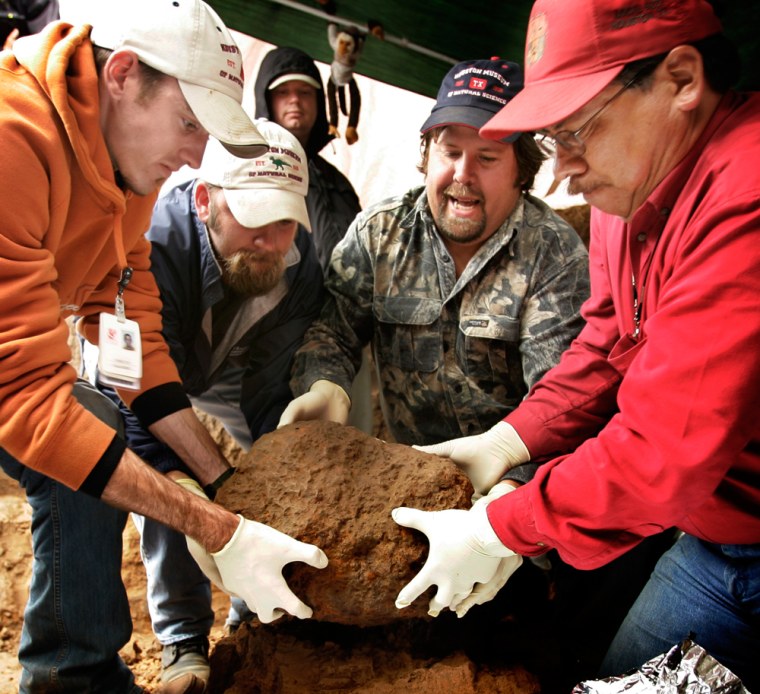Scientists located a rare meteorite in a Kansas wheat field thanks to new ground penetrating radar technology that some day might be used on Mars.
The dig Monday was likely the most documented excavation yet of a meteorite find, with researchers painstakingly using brushes and hand tools in order to preserve evidence of the impact trail and to date the event of the meteorite strike. Soil samples were also bagged and tagged, and organic material preserved for dating purposes.
Even before they had the meteorite out of the ground, the scientific experts at the site were able to debunk prevailing wisdom that the spectacular Brenham meteorite fall occurred 20,000 years ago. Its location in the Pleistocene epoch soil layer puts that date closer to 10,000 years ago.
"We know it is recent," said Carolyn Sumners, director of Astronomy at the Houston Museum of Natural Science, as she surveyed progress on the dig. "Native Americans could have seen it."

The scientific expedition of the meteorite strewn field in western Kansas was put together by the Houston Museum of Natural Science and led by meteorite hunters Steve Arnold and Philip Mani. Johnson Space Center's Lunar and Planetary Institute, the Rice Space Institute at Rice University and George Observatory in Houston also sent researchers.
Fewer than 1 percent of the meteorites discovered on earth are pallasite meteorites, known for their crystals embedded in iron, Mani said.
Sophisticated metal detectors at the site initially detected what had been thought to be the largest pallasite meteorite ever discovered. But ground penetrating radar showed that object to be a steel cable.
But with about a dozen potential targets on the site, the team still uncovered a sizeable pallasite buried four feet under the ground and located a quarter of a mile from where Arnold and Mani found the world's largest pallasite meteorite a year ago.
The newest find weighs 154 lbs and measures 18 by 12 by 12, which is bigger than most such meteorites but on par for this particular field, Arnold said.
"What is unique is not the size, but the fact it was found in context," said Patricia Reiff, director of the Rice Space Institute.
Researchers documented every aspect of the dig from various scientific disciplines. Among them were an archaeologist, a paleontologist, a naturalist, geologists, astronomers, and even an animator, who recreated the meteor fall for the museum.
But few garnered as much attention as Essam Heggy, planetary scientist at the Johnson Space Center's Lunar and Planetary Institute in Houston. It was his ground-penetrating technology that pinpointed the site and proved for the first time that the technology could be used to find objects buried deep in the ground and to make an accurate three-dimensional image of them.
"It validates the technique so we can use something similar to that instrument when we go to Mars," Reiff said.
Such GPR systems had been used in the past to locate smaller meteorites in Antarctica where ice allows easier penetration of the sonar. But until the Kansas dig, the technology had not been successfully used for ground detection in heavy soils, like what might be encountered in Mars, to find meteorites or water there.
"When we find a piece of meteorite, each one is a new sentence we add to the book to understand the evolution of the solar system," Heggy said.
The Brenham field was discovered in 1882. Scientists have since traced pieces of the shower as far away as Indian mounds in Ohio, indicating the meteorites were traded as pieces of jewelry and ceremonial artifacts. The site was largely forgotten in recent decades until Arnold and Mani leased eight square miles of it and began looking deep below the surface.
More than 15,000 pounds of meteorites have been recovered from the Brenham fall, with about a third of them found by the two men in the past year, Mani said. About three dozen meteorites have been pulled from the field by their Brenham Meteorite Co.
This week's find will end up as part of a new exhibit on comets, meteors, and asteroids at the Houston Museum of Natural Science. The museum will pay about $50,000 for it, Sumners said. It is valued at more than $100,000, she said.
Under the lease agreement, the landowner and meteorite hunters split the proceeds of any finds, Mani said.
Landowner Alan Binford watched with interest as the scientists freed the meteorite, bagging clumps of his rich Kansas farmland around it.
"I didn't figure there would be that much scientific value," he said. "I never thought about them going to this extent. It is interesting history."
